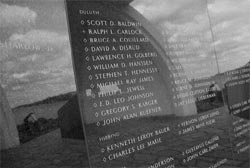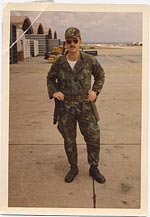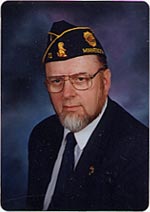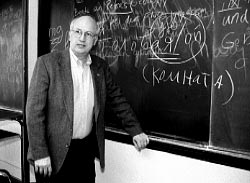| |
 |
 |
Writer
and former Marine Jim Northrup reflects on his Vietnam War experience.
See our
slideshow and hear excerpts from Northrup's story-poems. |
The Vietnam veteran is perhaps the most mythologized figure
to emerge from the war. Some three million men and women served
in Vietnam. Most are in their 50's now. Many veterans object to
what they consider myths perpetuated about them by the media, but
don't agree on what those myths are.
THE
VIETNAM WAR
- and the deep divide over its meaning - is seemingly hard-wired
into the soul and psyche of America. Duluth, Minnesota, the small
Lake Superior port city, is a long way from Saigon. Or, for that
matter, from the Pentagon or Berkeley. But Vietnam lives here, too.
"When I walk in here this is like holy ground," says
Durbin Keeney, strolling into the Vietnam War Memorial, a prominent
feature in a lakeside park. Dedicated in 1992, the memorial consists
of a concrete bunker-like structure - a half-dome with its back
to the lake. Across from it, as though taking shelter in the bunker,
is a black granite wall reminiscent of the much larger one in Washington
D.C.
 |
 |
| |
Vietnam
War Memorial, Duluth, Minnesota |
"The wall has 136 names on it, [including] 5 POW's...from
the 7 counties surrounding this area," says Keeney. "So
we're real proud of what we've put together here. To provide healing
for the families, for the community. I've come down here in the
middle of the night and found guys playing guitars and singing to
the wall."
Durbin Keeney is 51. He's a big man with red hair and a graying
beard. He served in Vietnam in 1970 and '71 as an Air Force security
officer. On this cool spring day, he wears a black jacket and a
cap with a visor; both declare him a Vietnam Veteran. So do Durbin's
belt buckle and his license plate. He says his fellow Vietnam veterans
are his life now. They are his vocation. Keeney runs a small non-profit
group that helps homeless veterans find housing, treatment and other
help.
 |
 |
 |
 |
 |
Durbin
Keeney, Dec. 1970 |
 |
Durbin
Keeney, today |
In the basement office of Keeney's agency, Veterans Outreach North,
counselor Earl Nett is on the phone with a troubled vet - trying
to get the man into treatment, Keeney explains. "Right, but
you're working through that," Nett says into the phone. "You're
letting go of the past."
The vet on the other end of the line may need to let go of the
past, but Durbin Keeney says he couldn't do it. In the 1970's and
'80s he worked in insurance and other business ventures, trying
to forget the war. Everything changed a few years ago, he says,
when he finally confronted his own Vietnam memories.
"There were times that I guarded the Blackbird," Keeney
recalls. "And the Blackbird would take off after the Freedom
Birds at night; the Freedom Birds took troops home, but the Blackbird
was where the soldiers who were killed were taken out." Even
thirty years later, the image brings tears; Keeney reaches into
his pocket for a handkerchief. "And the hardest thing that
I've always dealt with was what we call survivors' guilt. I made
it and somebody else didn't. I know now why. I believe very firmly
that there's rhymes and reasons why some of us survived and some
of us didn't - because that's allowed me to do what I'm doing today."
 |
 |
| |
Tom
Morgan |
Now, meet another Duluthian. At 55, Tom Morgan looks the part of
the college professor: herringbone jacket and round wire-rim glasses.
He teaches Russian language, literature and history - and Peace
Studies - at the College of St. Scholastica, a Catholic liberal
arts college in Duluth. He's a native; he graduated from the local
University of Minnesota campus before enlisting in the Navy and
going to Vietnam in 1968.
The walls of Morgan's small office are covered with photos, posters
and flyers - almost all of them having to do with Russia, Morgan's
academic field. There's no visible reference to Morgan's background
as a Vietnam GI. "It was definitely an important and defining
moment in my life and it has shaped me," Morgan says, "but
I continue to grow and expand and look forward."
In fact, though, Morgan does carry Vietnam with him. In mide-life
he's become a peace activist of sorts. A couple of years ago he
worked to defeat a plan to park a World War Two-era battleships
in the Duluth port as a tourist attraction - a project Durbin Keeney
actively supported. Morgan objected that the ship would glorify
war. He says his antiwar convictions grew straight out of Vietnam.
"I saw people get blown apart. I mean, that would get anybody
to question the value of any war. It is the worst possible solution
to problems."
As a young enlistee, Morgan recalls, he "didn't know what
to think about this war" but simply went along. "Because
we're all against Communism, aren't we? It took awhile for me to
understand the futility and hopelessness of that situation. And
also what we were doing to Vietnamese society - I mean, we just
did violence to that culture."
Tom Morgan and Durbin Keeney are just two veterans with two very
different ways of fitting Vietnam into their lives. Unlike the rest
of us who struggle over the meaning of that war, veterans have the
added experience - or burden - of watching politicians, the news
media and the makers of popular culture tell their story.
One recurring image is that of the violently unbalanced Vietnam
vet. The movies have churned out many such veterans; Robert De Niro's
deranged character in "Taxi Driver" is just one of many
in the genre.
To be sure, some Vietnam veterans are mentally ill. Some are chemically-addicted
and homeless. In the 1980's the Veterans Administration estimated
that 15% of Vietnam theater veterans suffered from post-traumatic
stress disorder. That's a significant figure - almost half a million
vets. But then 85% of Vietnam vets did not have PTSD. These estimates
make perfect sense when you consider that only 15-20% of Vietnam
GI's saw serious combat, according to experts.
Veteran B.G. Burkett, a Dallas stockbroker and author of a book
on vets called "Stolen Valor," says he looked hard at
government statistics. He thinks most people will be surprised by
what he found: "We had the lowest unemployment rate of any
major category. Had the highest per capita income, had the highest
educational rate. We had the lowest criminality rates of any group
in America. You know, you don't go through three years of military
discipline and then come out and say, boy, I'm gonna go rob a bank
or shoot my mother. It didn't happen, but that was what became the
theme in Hollywood."
Another stock Hollywood character is the gung ho Vietnam fighter
turned veteran-with-a-grudge. Like John Rambo. In the first Rambo
film the former Green Beret unleashed his fury on a small town in
the Pacific Northwest. "You're goddamn lucky he didn't kill
all of you," Rambo's former commanding officer tells the local
police chief.
As in Rambo's case, the grudge held by Vietnam vets in the movies
is usually directed toward the antiwar movement and a government
that didn't wage an all-out attack. "I did what I had to do
to win, but somebody wouldn't let us win!" Rambo screams in
a climactic speech.
"So the loss of the war is attributed to something that happened
on the home-front," says Jerry Lembcke, a Vietnam veteran and
a sociologist at Holy Cross College. "We were sold out by liberals
in Congress who wouldn't fund the war and who wouldn't approve the
military strategy that we needed to win the war, and we were stabbed
in the back by the anti-war movement in the streets that demoralized
our soldiers in Vietnam and gave aid and comfort to the enemy that
we were fighting against."
Lembcke analyzed media and pop-culture portrayals of Vietnam veterans,
and of their coming-home experience, for his recent book, "The
Spitting Image." He says most vets in the movies loathed the
antiwar movement and expressed anger that they weren't allowed to
win the war, but that's not Lembcke's view. He insists most vets
he knows don't feel that way, either; nor did most of the GI's he
knew in Vietnam. He served as an Army Chaplain's Assistant in 1969.
In the unit in which Lembcke served as an Army Chaplain's Assistant,
in 1969, "I would say most of the men there couldn't wait to
get home to join the anti-war movement. The prevailing opinion was
that the people at home who are protesting the war are right, they're
on the right side of this issue. And we're on the wrong side."
There are no firm statistics on how many Vietnam GI's actively
opposed their own war. Most experts say it was far short of a majority.
But a Harris Poll commissioned by the VA in 1971 offers partial
support for Lembcke's claim that Vietnam GI's and the antiwar movement
were not bitterly at odds with one another; at least, returning
soldiers did not see themselves as under attack by peace activists.
Asked to respond to the statement, "Those people at home who
oppose the Vietnam war often blame veterans for our involvement
there," 75% of veterans disagreed.
B.G. Burkett did see the antiwar movement as the enemy, and still
does. "They energized the other side," he says today.
"I don't know how anyone could be proud of a movement that
put 20 million people under communism." In contrast to Lembcke's
description of soldiers anxious to go home and protest the war,
Burkett says the men in his infantry unit were "gung-ho"
- proud and enthusiastic warriors.
One partial reason for such sharp differences in the perceptions
of veterans: support for the war back home, and the perceived prospects
for victory, declined sharply during the seven years of heavy American
involvement in Vietnam. Burkett did his tour one year before Lembcke
did, in 1968. "The morale did not really decline until probably
mid-'69," Burkett says. "And then of course by '70, '71
it got terrible. Because by that time the peace talks had started,
Nixon's talking peace with honor, and so...you know you're not there
to win a war and the only thing that's going to happen to you the
longer you stay there is you're going to get killed or wounded."
Indeed, military leaders themselves recognized a crisis among Vietnam
soldiers in the war's last years. In an article called "The
Collapse of the Armed Forces" published in the Armed Forces
Journal in June, 1971, Colonel Robert Heinl declared that the army
in Vietnam was "dispirited where not near mutinous."
That's an apt description of a group of soldiers at Fire Base Pace
in South Vietnam in October, 1971. In a report for Pacifica Radio,
journalist Richard Boyle went to the base to interview a dozen "grunts"
from the First Cavalry Division. The GI's had been ordered on a
nighttime combat mission the previous night. Six of the men had
refused to go and several others had objected to the order.
"They'll have to court-martial the whole company," one
soldier told Boyle. "I say right away they can start typing
up my court-martial."
The GI's told Boyle they objected not only to what they saw as
a suicidal mission but to the war effort itself. Their commanding
officer wouldn't let them wear t-shirts with peace symbols, they
complained. "He calls us hypocrites if we wear a peace sign,"
one GI said. "[As if] we wanted to come over here and fight. Like
we can't believe in peace, man, because we're carrying [an M-16]
out there."
Another soldier piped in: "I always did believe in protecting
my own country, if it came down to that. But I'm over here fighting
a war for a cause that means nothing to me."
Historians say so-called "combat refusals" became increasingly
common in Vietnam after 1969. Soldiers also expressed their opposition
to the war in underground newspapers and coffee-house rap sessions.
Some wore black armbands in the field. Some went further.
"During the years of 1969 down to 1973, we have the rise of
fragging - that is, shooting or hand-grenading your NCO or your
officer who orders you out into the field," says historian
Terry Anderson of Texas A & M University. "The US Army
itself does not know exactly how many...officers were murdered.
But they know at least 600 were murdered, and then they have another
1400 that died mysteriously. Consequently by early 1970, the army
[was] at war not with the enemy but with itself."
Of course, the vast majority of Vietnam GI's carried out their
orders and returned home. Some - especially those who served in
the early years of American involvement - were even greeted as heroes,
just like those from World War Two or some other "good war."
A Universal Studios newsreel circulated at the end of 1966 shows
a large crowd gathered at Kelly Air Force Base in San Antonio to
"give a very special welcome home to some very special people,"
as the big-voiced narrator put it. President Lyndon Johnson and
his wife Ladybird were there. "The President expresses the
gratitude of a grateful nation," summed up the narrator.
But by the end of the war there was not much sunny talk of a "grateful
nation." The country had lost its first war. Americans were
profoundly divided over the conflict and held complicated feelings
about its veterans. From the late 1970's on, politicians, the media
and moviemakers dwelled increasingly on the troubles of returning
vets, says sociologist Lembcke. "What popular culture did was
rewrite the history, rewrite the story of the Vietnam war in many
ways as being a story about veterans coming home from the war."
In other words, the nation's public soul-searching on Vietnam turned
to questions about post-traumatic stress disorder, the lack of welcome-home
parades and POW/MIA's. Lembcke and some others who've thought about
Vietnam for decades now wish Americans would place more focus on
other troubling questions: Why did we send those men and women to
Vietnam in the first place? What did we ask them to do on our behalf?
By not thinking too hard about those questions, Americans can preserve
a cherished image of their country as one that always stands for
liberty and justice in the world, says historian Marilyn Young of
New York University: "It's a lot to give up, when you think
about it, to reckon rather closely with the actual history of any
country and what it's done in the world, and what any government
has done abroad and to its own people. That's a lot to come to terms
with. And I think people don't want to give up the simple story.
'Cause it's a nicer story. And it always has a happy ending."
There's no sign of consensus among Vietnam vets about the meaning
of their war. As one veteran in Duluth says: the conversation is
still continuing.
|

